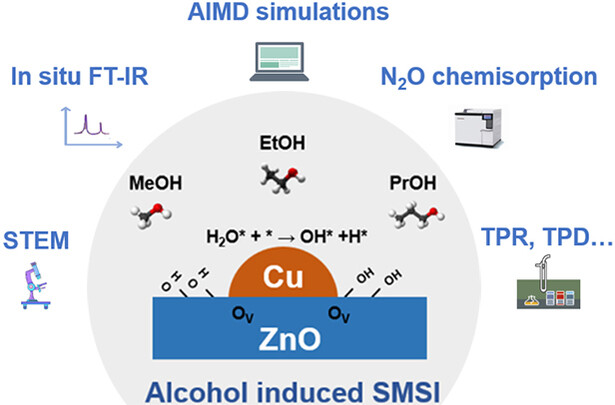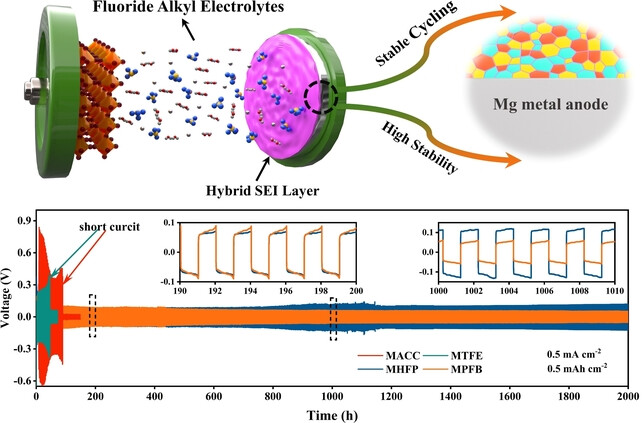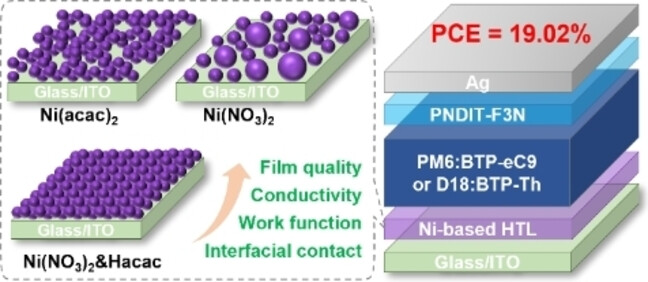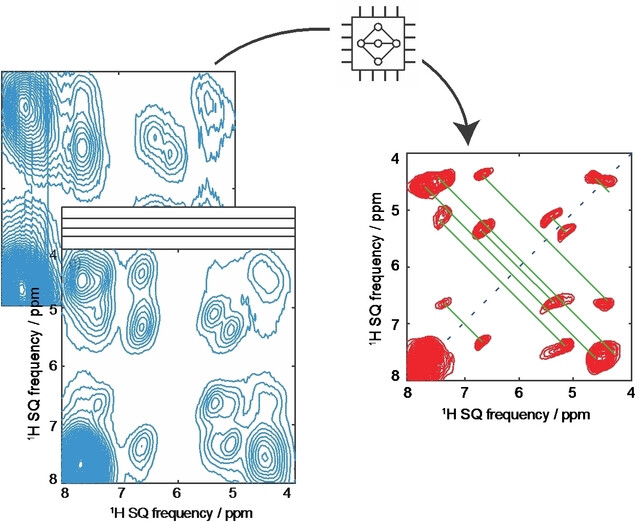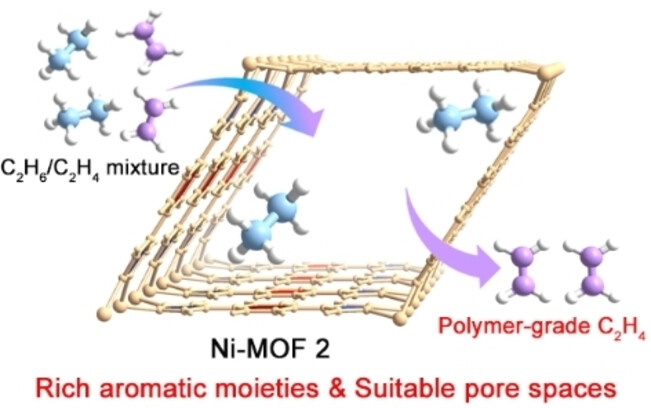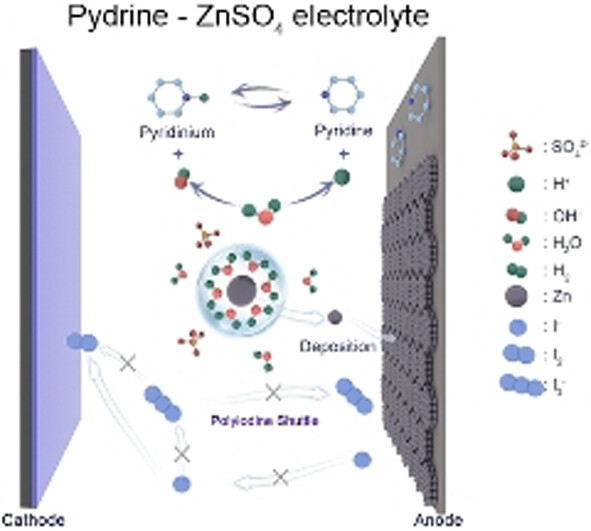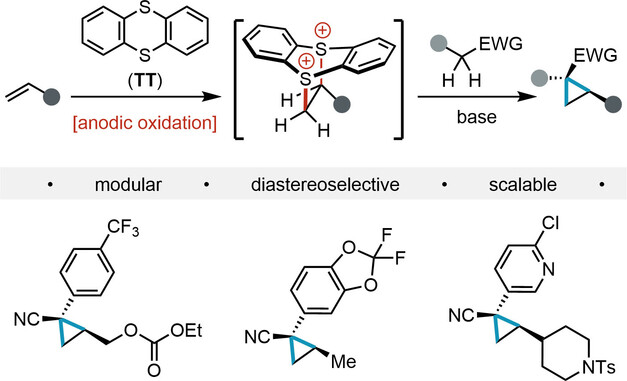Journal list menu
Export Citations
Download PDFs
Titelbild
Titelbild: Lewis-Pairing-Induced Electrochemiluminescence Enhancement from Electron Donor-Acceptor Diads Decorated with Tris(pentafluorophenyl)borane as an Electrochemical Protector (Angew. Chem. 21/2023)
- First Published: 27 April 2023
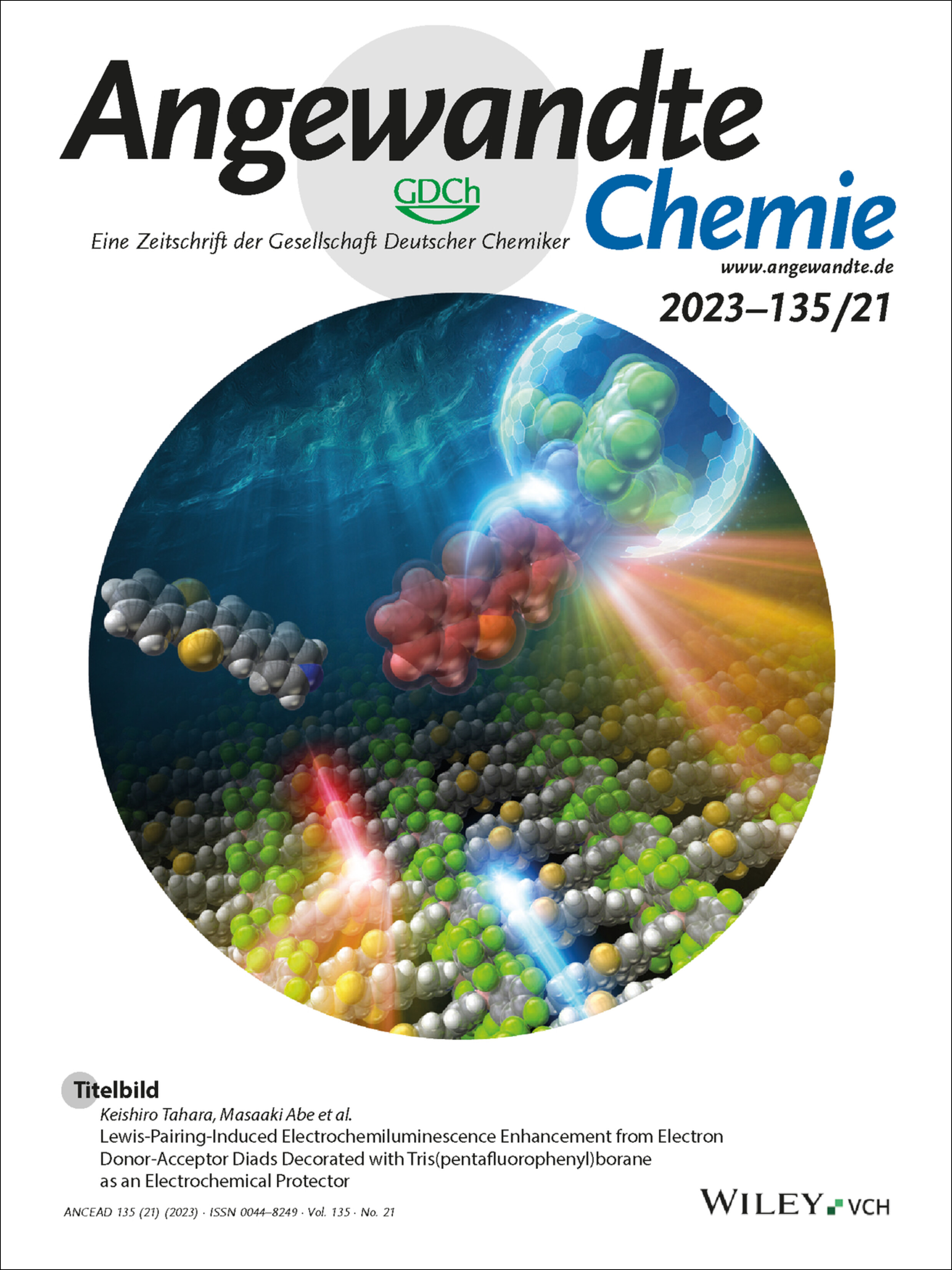
Elaborate metal-free electrochemiluminescence (ECL) systems require highly robust organic emitters in the radical form. In their Research Article (e202301109), Keishiro Tahara, Masaaki Abe, and co-workers used the classical Lewis acid B(C6F5)3 as an electrochemical protector of donor–acceptor emitters, leading to the discovery of Lewis-pairing-induced ECL enhancement. The Lewis acid also converted the molecular arrangements of the emitters, playing a unique role in crystalline-film ECL.
Innentitelbild: Giving Gold Wings: Ultrabright and Fragmentation Free Mass Spectrometry Reporters for Barcoding, Bioconjugation Monitoring, and Data Storage (Angew. Chem. 21/2023)
- First Published: 28 April 2023
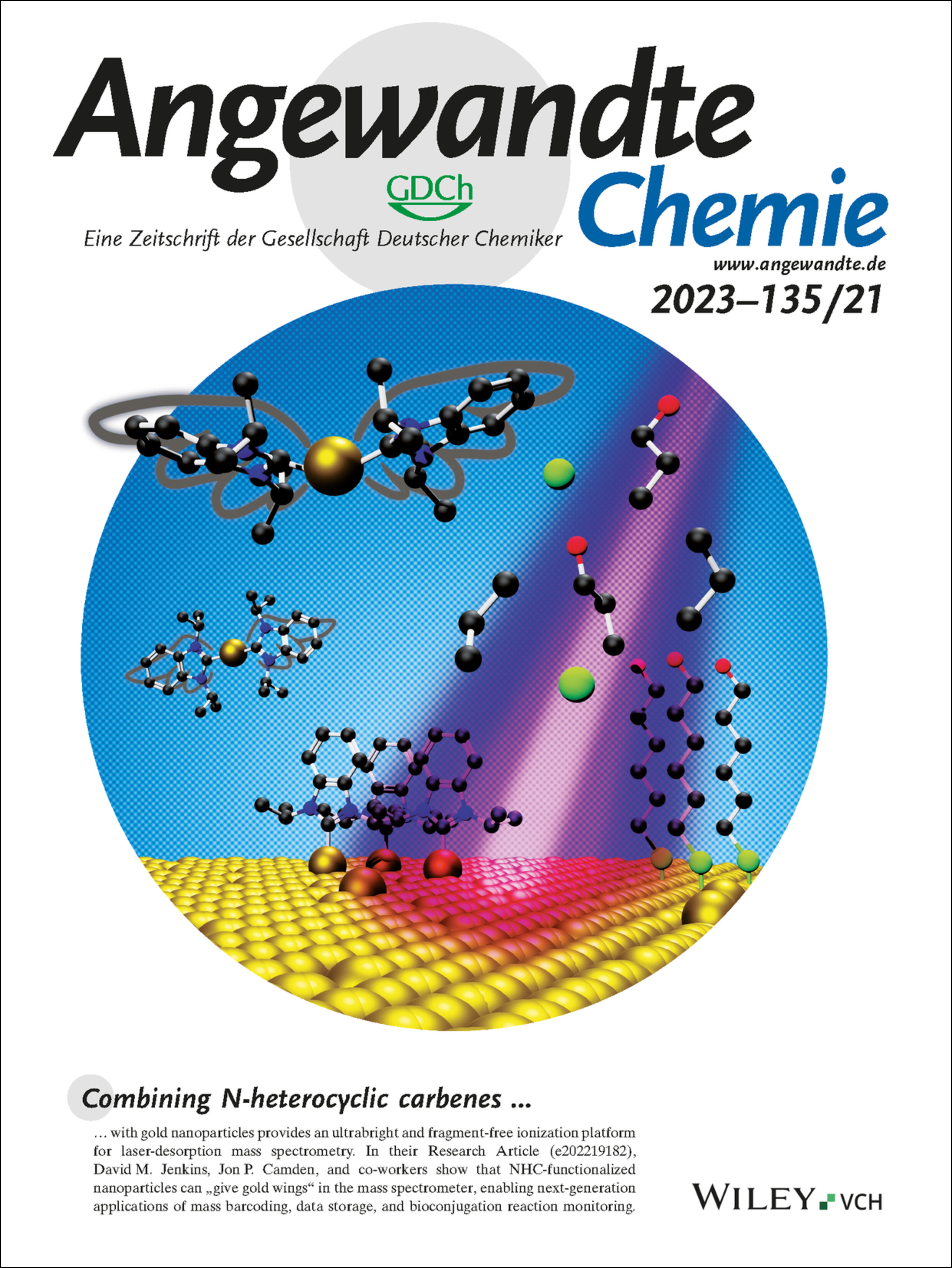
Combining N-heterocyclic carbenes with gold nanoparticles provides an ultrabright and fragment-free ionization platform for laser-desorption mass spectrometry. In their Research Article (e202219182), David M. Jenkins, Jon P. Camden, and co-workers show that NHC-functionalized nanoparticles can “give gold wings” in the mass spectrometer, enabling next-generation applications of mass barcoding, data storage, and bioconjugation reaction monitoring.
Innenrücktitelbild: Surfactant Directed Synthesis of Intrinsically Chiral Plasmonic Nanostructures and Precise Tuning of their Optical Activity through Controlled Self-Assembly (Angew. Chem. 21/2023)
- First Published: 24 April 2023
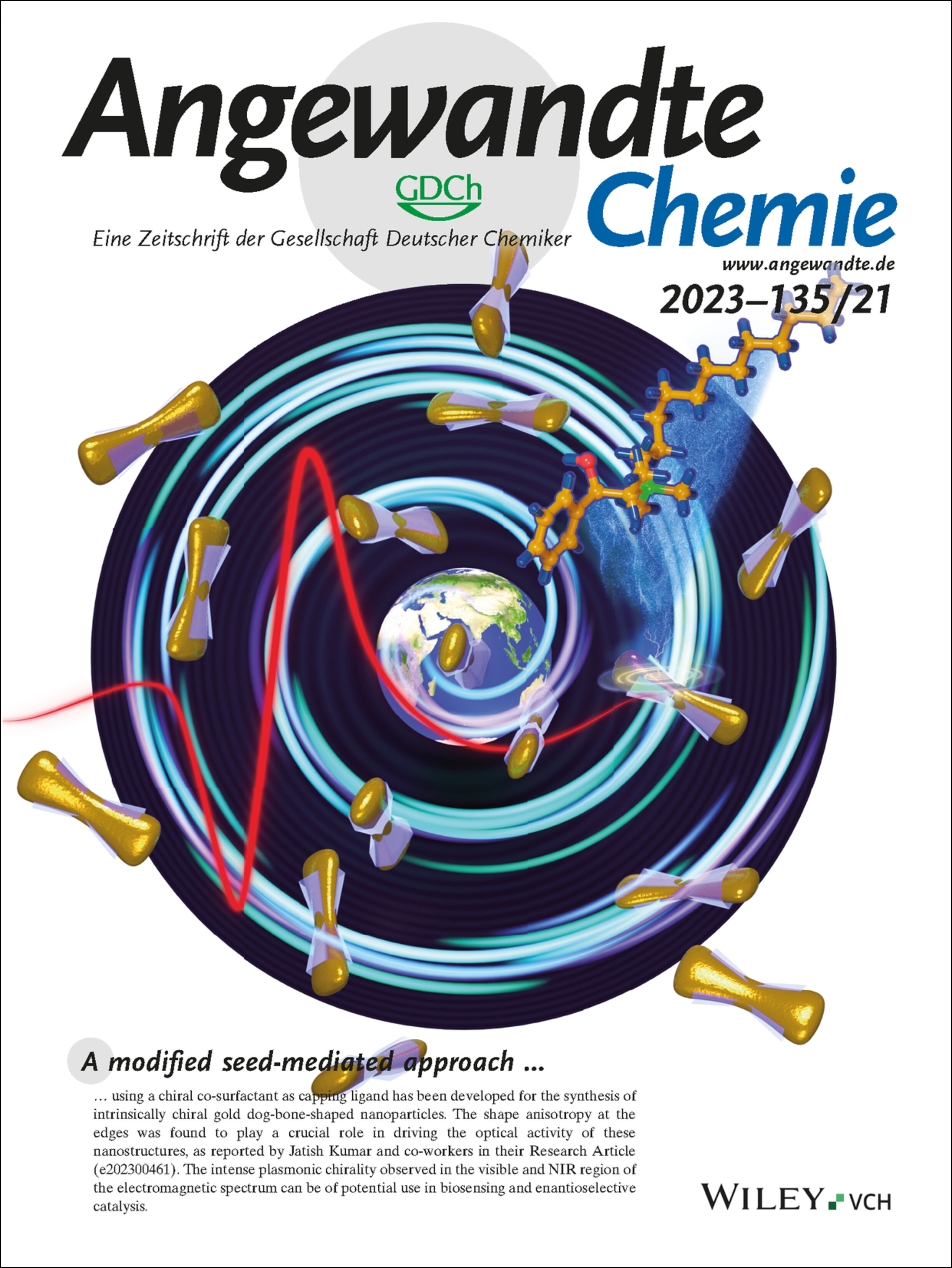
A modified seed-mediated approach using a chiral co-surfactant as capping ligand has been developed for the synthesis of intrinsically chiral gold dog-bone-shaped nanoparticles. The shape anisotropy at the edges was found to play a crucial role in driving the optical activity of these nanostructures, as reported by Jatish Kumar and co-workers in their Research Article (e202300461). The intense plasmonic chirality observed in the visible and NIR region of the electromagnetic spectrum can be of potential use in biosensing and enantioselective catalysis.
Rücktitelbild: Metal-Organic Framework Supported Copper Photoredox Catalysts for Iminyl Radical-Mediated Reactions (Angew. Chem. 21/2023)
- First Published: 04 May 2023

A binap-ligated copper iodide dimer embedded on a metal−-organic framework (MOF) was designed as an effective photoredox catalyst by Dan Li, Jian He, and co-workers in their Research Article (e202300233). Under visible-light irradiation, this heterogenized copper(I) complex promotes multiple iminyl radical-mediated reactions initiated by N−O bond cleavage, with significantly enhanced photocatalytic activity compared to its homogeneous counterparts. The use of a hydroxamic acid linker for post-synthetic modification renders the catalyst recyclable.
Frontispiz
Frontispiz: Achieving High Single-Pass Carbon Conversion Efficiencies in Durable CO2 Electroreduction in Strong Acids via Electrode Structure Engineering
- First Published: 04 May 2023

Electrocatalysis. In their Research Article (e202300226), Miao Zhong and co-workers developed an electrode-structureengineering strategy to achieve efficient, selective, and stable CO2 reduction with high CO2 utilization.
Frontispiz: Synthesis of Erythrocyte Nanodiscs for Bacterial Toxin Neutralization
- First Published: 04 May 2023
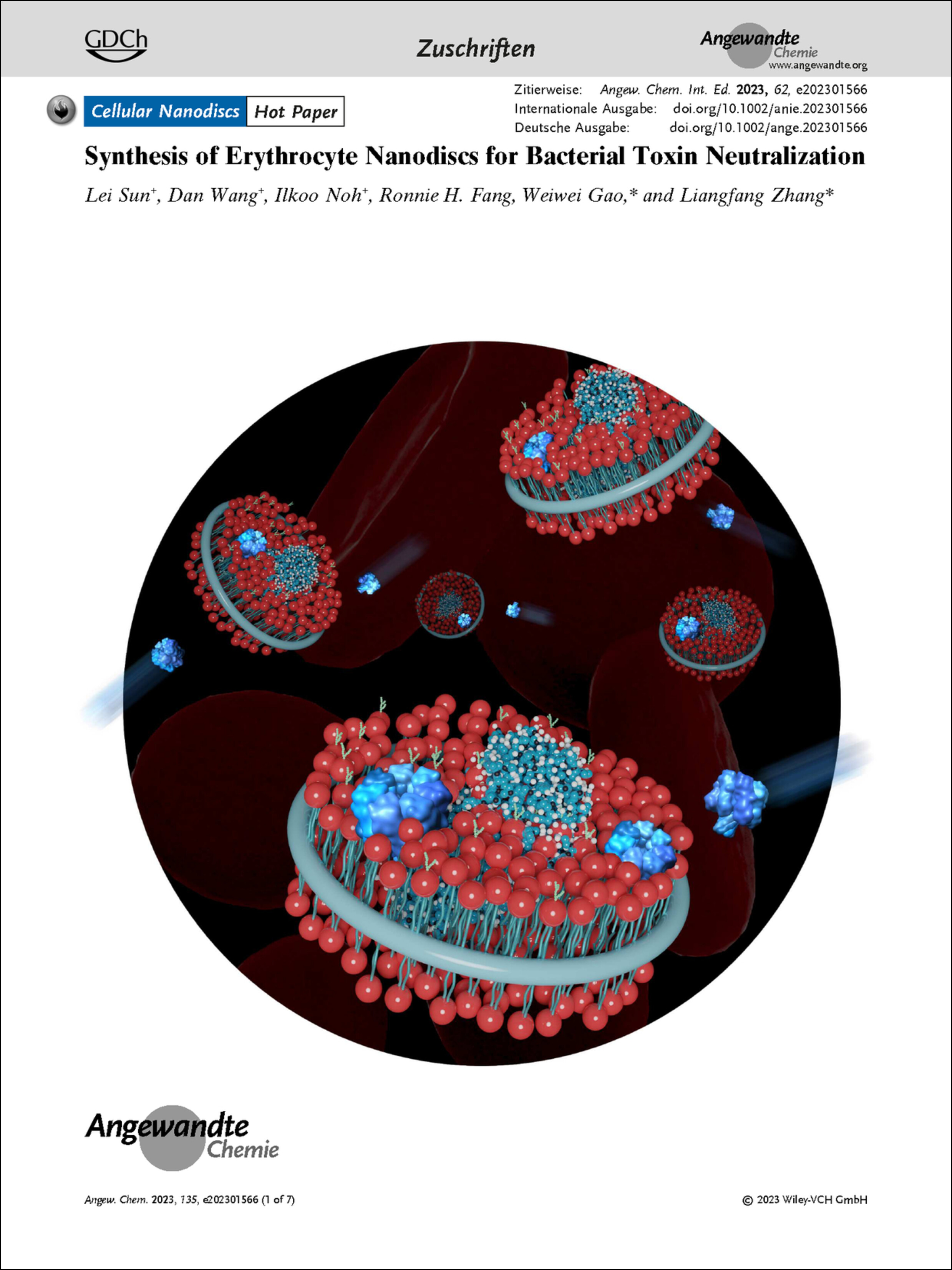
Drug Delivery. In their Communication (e202301566), Weiwei Gao, Liangfang Zhang et al. report a nanodisc formulation made with natural human red blood cell membrane and demonstrate its robust application for bacterial toxin neutralization.
Graphisches Inhaltsverzeichnis
Introducing …
Team Profile
A Team for Accelerating Catalyst and Reaction Development
- First Published: 24 March 2023

“Experience in both catalyst and reaction design is required to solve remaining limitations and to set new standards … In contrast to previous studies, we aimed at the design ofnew catalysts based on data rather than on chemical intuition.“ Find out more about the collaborative work in the Gessner and Gooßen groups on accelerating catalyst and reaction development.
Highlights
Electrochemistry
Electrochemical Reactors Enable Divergent Site Selectivity in the C−H Carboxylation of N-Heteroarenes
- First Published: 14 March 2023
Kurzaufsätze
Conjugated Polymers
Cross-Dehydrogenative Coupling Polymerization via C−H Activation for the Synthesis of Conjugated Polymers
- First Published: 27 February 2023

Cross-dehydrogenative coupling (CDC) via C−H activation is the latest addition in the repertoire of synthetic strategies towards conjugated polymers. This article captures the development of this polymerization strategy in the light of background small molecule reactions and highlights how its approach is greener than the previous methods. Arene–arene and arene–alkene couplings via transition metal catalysts have been explored for CDC polymerization.
Medizinische anorganische Chemie
Immunogenen Zelltod induzierende Metallkomplexe für die Krebstherapie
- First Published: 21 February 2023

Metastasen und Tumorrückfälle sind die Hauptursachen für krebsbedingte Todesfälle. Neben anderen Ansätzen gilt ein großes Forschungsinteresse immunogenen, den Zelltod auslösenden Wirkstoffen, die in der Lage sind, sowohl den lokalen Zelltod der Krebszellen auszulösen als auch eine Immunreaktion im gesamten Organismus zu induzieren. In diesem Artikel wird die Anwendung von Metallkomplexen als immunogene, den Zelltod auslösende Verbindungen systematisch untersucht.
Aufsätze
Solar Cells
Harnessing the Structure-Performance Relationships in Designing Non-Fused Ring Acceptors for Organic Solar Cells
- First Published: 16 February 2023
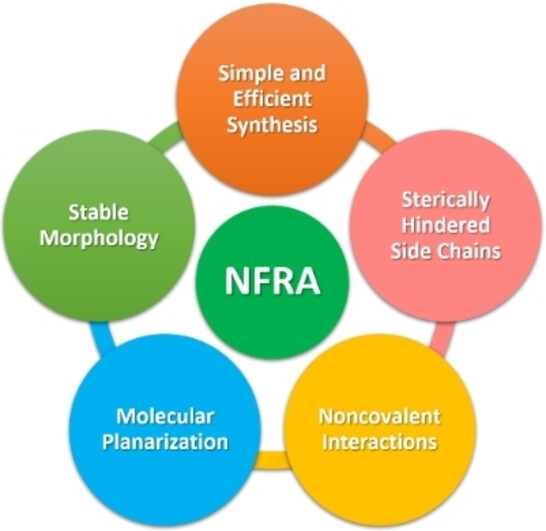
Non-fused ring acceptors for organic solar cells are presented in this Review from the viewpoint of materials design. The cencepts of noncovalent interactions, insertion of sterically hindered side chains, and planarization of the molecular backbone by conformational locking are summarized toward the design of high-performance materials.
Nanomaterials
Supercritical CO2-Induced Amorphization in 2D Materials: Mechanism and Applications
- First Published: 27 February 2023
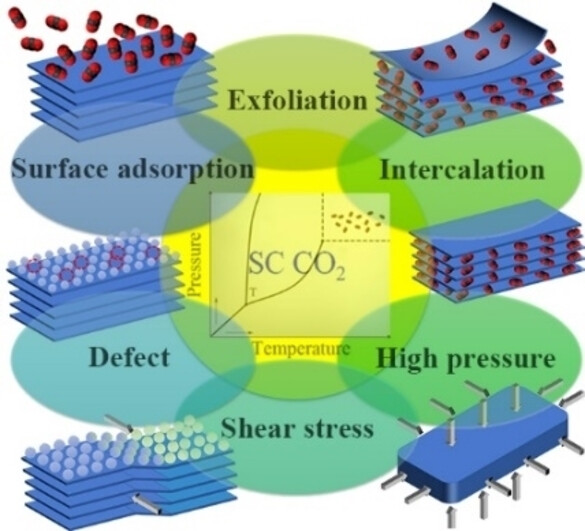
This review highlights recent achievements in the fabrication of amorphous nanomaterials with the assistance of supercritical carbon dioxide (SC CO2) and discusses the underlying amorphization mechanism. The application of amorphous nanomaterials in different fields is summarized, thus demonstrating the prospects of SC CO2.
Forschungsartikel
CO2 Reduction | Hot Paper
Achieving High Single-Pass Carbon Conversion Efficiencies in Durable CO2 Electroreduction in Strong Acids via Electrode Structure Engineering
- First Published: 21 February 2023
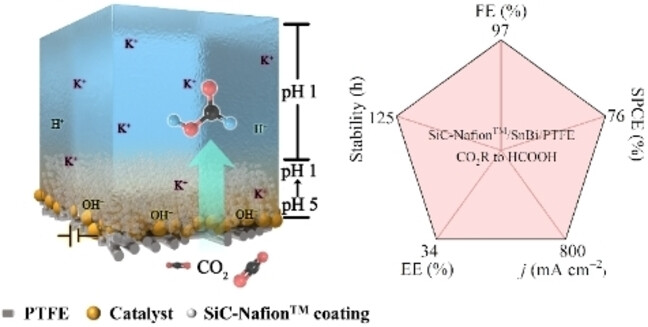
An electrode-structure-engineering strategy is developed to achieve efficient, selective, and stable CO2 reduction (CO2R) with high CO2 utilization. This strategy creates a near-neutral pH and enriches K+ near catalyst surfaces during CO2R in strong acids. A stratified SiC-NafionTM/SnBi/polytetrafluoroethylene (PTFE) electrode consistently produces formic acid with a single-pass carbon efficiency of >75 % and Faradaic efficiency of >90 % at 100 mA cm−2, lasting over 125 h at pH 1.
G Protein-Coupled Receptors
Monitoring the Reversibility of GPCR Signaling by Combining Photochromic Ligands with Label-free Impedance Analysis
- First Published: 18 March 2023
Nanopores
Site-Specific Introduction of Bioorthogonal Handles to Nanopores by Genetic Code Expansion
- First Published: 16 March 2023
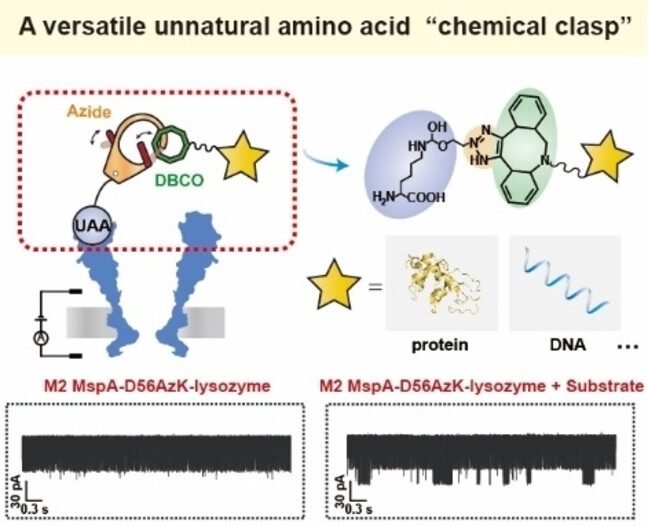
Using the genetic code expansion strategy, an azido amino acid was site-specifically incorporated into a biological nanopore and served as a “chemical clasp”, enabling bioorthogonal conjugation of DNA or proteins to generate nanopore sensors with novel sensing capacities. The lysozyme-conjugated pore was further demonstrated as a proof-of-principle for the discrimination of different oligosaccharides.
Formylation Reactions
Tailoring Active Cu2O/Copper Interface Sites for N-Formylation of Aliphatic Primary Amines with CO2/H2
- First Published: 23 March 2023
Covalent Organic Frameworks
Stable Immobilization of Nickel Ions on Covalent Organic Frameworks for Panchromatic Photocatalytic Hydrogen Evolution
- First Published: 24 March 2023
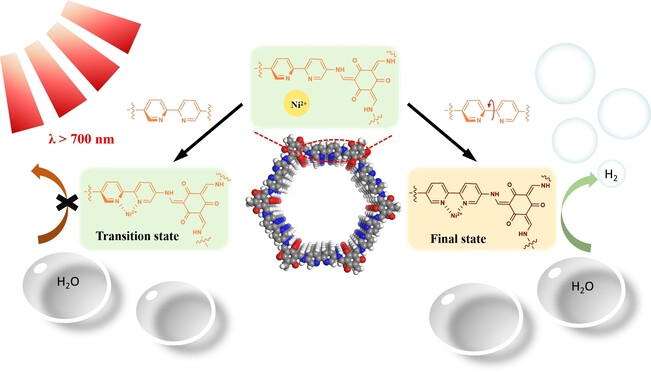
Unlocking a stacked layered structure of a two-dimensional covalent organic framework (COF) is achieved by solvothermal conditions to enable stable coordination with Ni(II) ions via the 2,2’-bipyridine moiety. This COF-Ni(II) complex exhibits an improved light absorption ability and boosts photocatalytic H2 generation (51,300 μmol h-1 g-1) in a total visible spectrum, even under 700-nm irradiation.
Metal Resource Recovery
Electrochemical-Mediated Regenerable FeII Active Sites for Efficient Uranium Extraction at Ultra-Low Cell Voltage
- First Published: 11 March 2023
Mechanochemistry
Mechanochemical Approach for Air-Tolerant and Extremely Fast Lithium-Based Birch Reductions in Minutes
- First Published: 21 March 2023

A mechanochemical Birch reduction is reported for the first time. The newly developed ball-milling method does not require an inert atmosphere or other special precautions. Notably, the reaction reached completion within one minute for most of the investigated substrates. The present study thus provides a novel, operationally simple, rapid, and scalable alternative to conventional solution-based Birch reduction.
Oxygen Evolution Reaction | Hot Paper
Origin of Surface Reconstruction in Lattice Oxygen Oxidation Mechanism Based-Transition Metal Oxides: A Spontaneous Chemical Process
- First Published: 16 March 2023
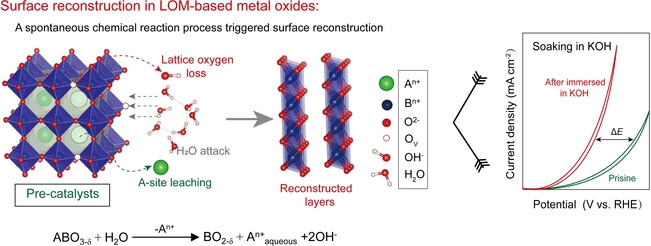
The surface reconstruction of Lattice oxygen oxidation mechanism (LOM)-based metal oxides in alkaline medium was unveiled to be triggered by a spontaneous chemical reaction, instead of an electrochemical reaction. During the chemical process, the activated lattice oxygen atoms were attacked by adsorbed water molecules firstly, leading to the formation of hydroxide ions (OH−). Then, the metal-site soluble atoms leached from the oxygen-deficient surface.
C-H Functionalization
Enantioselective Synthesis of N-N Atropisomers by Palladium-Catalyzed C−H Functionalization of Pyrroles
- First Published: 20 March 2023

Enantioselective synthesis of N−N indole-pyrrole and bisindole atropisomers was achieved by a palladium-catalyzed TDG-enabled C−H functionalization. A wide variety of the N−N atropisomers were produced in good yields with excellent enantioselectivities by C−H alkenylation, alkynylation, allylation or arylation reactions.
Mass Spectrometry
Giving Gold Wings: Ultrabright and Fragmentation Free Mass Spectrometry Reporters for Barcoding, Bioconjugation Monitoring, and Data Storage
- First Published: 28 February 2023
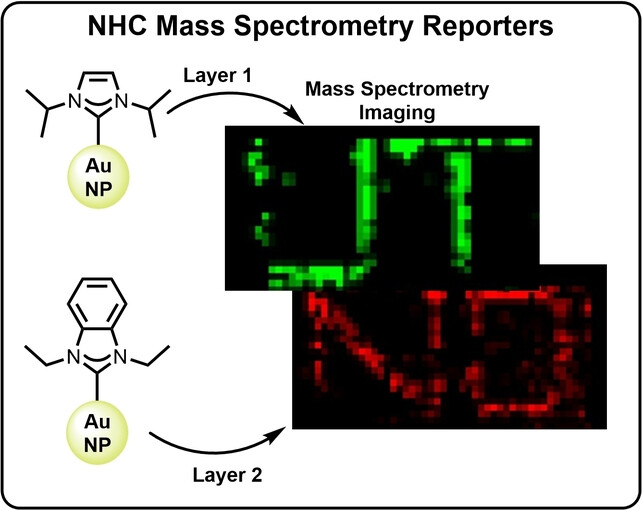
N-Heterocyclic Carbene (NHC) functionalized gold nanoparticles (AuNPs) are highly tunable and bright mass spectrometry reporters. NHC ligands fragment less and achieve higher ion yield than conventional thiol systems, which enables bioconjugation monitoring, mass spectrometry imaging, and data storage applications.
Perovskites
Low-Dimensional Phase Regulation to Restrain Non-Radiative Recombination for Sky-Blue Perovskite LEDs with EQE Exceeding 15 %
- First Published: 15 March 2023

The high-performing sky-blue perovskite light-emitting diodes (PeLEDs) with peak external quantum efficiency exceeding 15 % are attained by the use of a synergetic modulation strategy, regarding defect passivation and phase distribution regulation, via the incorporation of a bifunctional molecular additive.
Metal-Organic Frameworks | Hot Paper
Metal-Organic Framework Supported Copper Photoredox Catalysts for Iminyl Radical-Mediated Reactions
- First Published: 10 March 2023
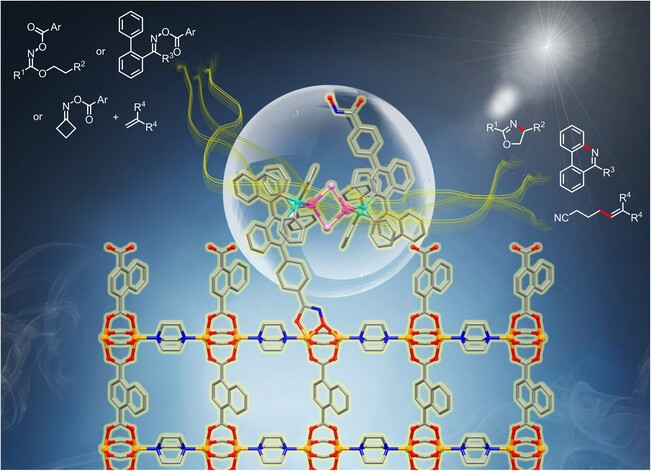
A binap-ligated copper dimer has been heterogenized on a pillar-layered MOF surface for the first time using a hydroxamic acid linker. This MOF-supported dimeric copper photocatalyst demonstrates much higher activity and recyclability than its homogeneous counterparts in intra- and intermolecular radical reactions of N-acyloxy imidates and O-acyl oximes.
Chiral Nano-assemblies
Surfactant Directed Synthesis of Intrinsically Chiral Plasmonic Nanostructures and Precise Tuning of their Optical Activity through Controlled Self-Assembly
- First Published: 13 February 2023

A facile protocol is demonstrated for the synthesis of intrinsically chiral dog-bone shaped gold nanostructures that displayed optical activity in the visible and NIR region of the electromagnetic spectrum. The controlled assembly of the nanostructures resulted in the enhancement and precise tuning of plasmonic chirality offering potential for application in the fields of enantioselective recognition, asymmetric catalysis, and spintronics.
Hydrogen Peroxide Production
Contact-electro-catalysis for Direct Synthesis of H2O2 under Ambient Conditions
- First Published: 22 March 2023
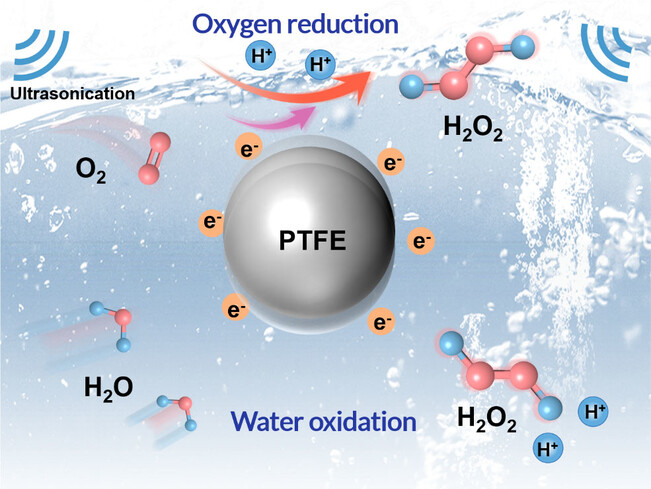
It is challenging to prepare H2O2 in a green, safe, simple and efficient way under ambient conditions. We proposed a facile approach for the direct production of H2O2, relying on contact-electro-catalysis between Polytetrafluoroethylene particles and deionized water without any other traditional catalysts.
Soft Matter | Hot Paper
A Facile Strategy for the Development of Recyclable Multifunctional Liquid Crystal Polymers via Post-Polymerization Modification and Ring-Opening Metathesis Polymerization
- First Published: 22 March 2023

We present a new synthetic strategy to combine the post-polymerization modification (PPM) and the ring-opening metathesis polymerization (ROMP) for designing multifunctional linear liquid crystal polymers (LLCPs). A photo- and humidity-responsive LLCP is demonstrated to show the potential of this synthetic strategy to offer broader opportunities to structurally diversify LCPs.
Li Metal Batteries
Cyclopentylmethyl Ether, a Non-Fluorinated, Weakly Solvating and Wide Temperature Solvent for High-Performance Lithium Metal Battery
- First Published: 22 March 2023

An original molecular design is reported to tailor the solvating power and physicochemical properties of non-fluorinated ether solvents. Eliminating one O atom and increasing steric hinderance in DME leads to cyclopentylmethyl ether (CPME) with significantly weakened solvating power and well extended temperature range of liquid phase from −140 °C and 106 °C, showing a great prospect for wide temperature lithium metal batteries.
Asymmetric Synthesis
Direct Catalytic Asymmetric and Regiodivergent N1- and C3-Allenylic Alkylation of Indoles
- First Published: 21 March 2023
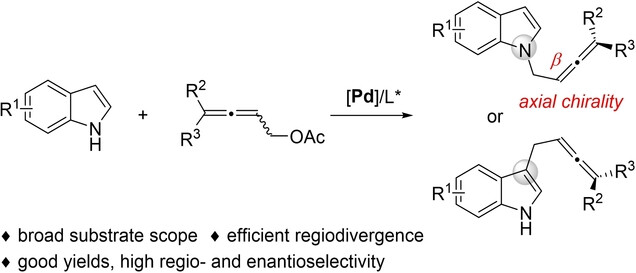
We report the first direct catalytic asymmetric N1-functionalization of 1H-indoles via an allenylic alkylation strategy. This transformation produces N-alkylated indoles bearing axial chirality with a stereocenter non-adjacent (β) to the nitrogen. The regioselectivity (N1/C3) of this process can be switched efficiently. We also introduce a new class of tri-substituted allenylic electrophiles.
Chemical Stepping | Hot Paper
Mobile Molecules: Reactivity Profiling Guides Faster Movement on a Cysteine Track
- First Published: 17 March 2023

Chemical stepping of biopolymers within a protein nanopore suggests an enzymeless means of sequence characterization. Using a nanoreactor approach, we elucidated the reactivity profile of cysteine footholds along a protein track. Faster chemical stepping was achieved by rational mutagenesis and optimization of reaction conditions. In the future, the system has the potential for directional molecular motion at milliseconds per step.
Self-assembled Clusters
Self-assembly Induced Enhanced Electrochemiluminescence of Copper Nanoclusters Using DNA Nanoribbon Templates
- First Published: 23 March 2023
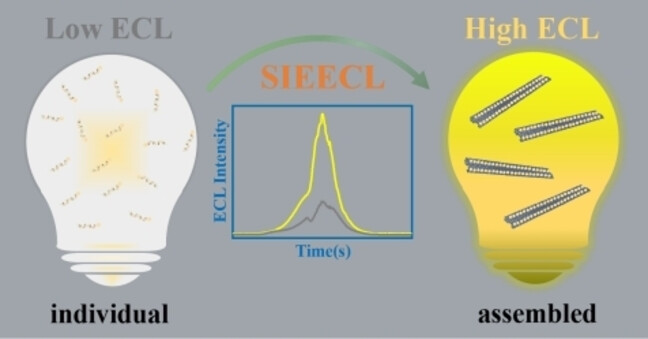
The concept of self-assembly induced enhanced electrochemiluminescence (SIEECL) using programmable DNA nanoribbon was proposed for the first time. This novel concept is confirmed in various ECL emitters, such as copper nanoclusters, gold nanoclusters and Ru(bpy)32+/TPrA system. Accelerated electron transfer reaction and reduced energy gap contribute to the enhancement of ECL.
Room-Temperature Phosphorescence
Phosphine-Manipulated p-π and π-π Synergy Enables Efficient Ultralong Organic Room-Temperature Phosphorescence
- First Published: 20 March 2023
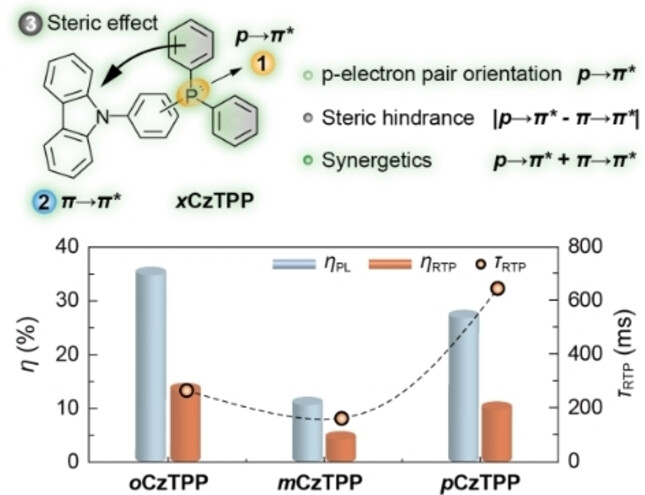
Room-temperature phosphorescence (RTP) with p-π and π-π synergy is realized by combining phosphine and carbazole groups in three hybrid molecules (xCzTPP). The harmonized p-electronic feature and steric effect of the phosphine group result in RTP efficiency and lifetime of para-substituted pCzTPP up to 13.8 % and 645 ms, respectively, owing to its sequential and complementary triplet p-π and π-π components in intersystem crossing and triplet energy-transfer processes.
Donor-Acceptor Systems | Hot Paper
Lewis-Pairing-Induced Electrochemiluminescence Enhancement from Electron Donor-Acceptor Diads Decorated with Tris(pentafluorophenyl)borane as an Electrochemical Protector
- First Published: 06 March 2023
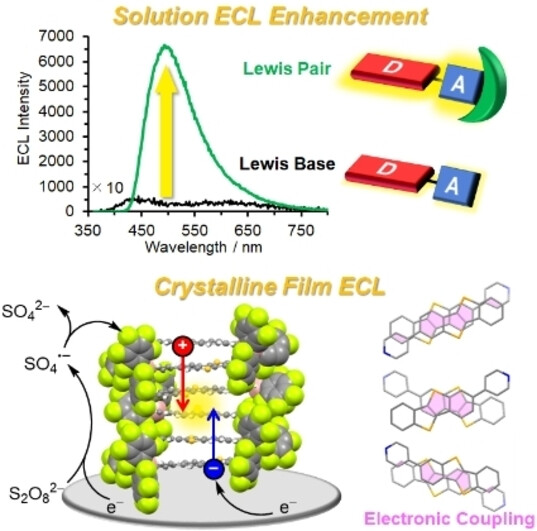
The feasibility of electrochemical protectors was demonstrated with a classical Lewis acid B(C6F5)3, which was mounted on donor-acceptor emitters to greatly stabilize electrogenerated radicals and enhance the Lewis-pairing-induced electrochemiluminescence (ECL). Electrochemical doping in segregated emitter-B(C6F5)3 co-assemblies afforded a crystalline film showing ECL through singlet exciton delocalization derived from columnar π-stacks.
Acidic Oxygen Evolution
Light-driven Orderly Assembly of Ir-atomic Chains to Integrate a Dynamic Reaction Pathway for Acidic Oxygen Evolution
- First Published: 20 March 2023
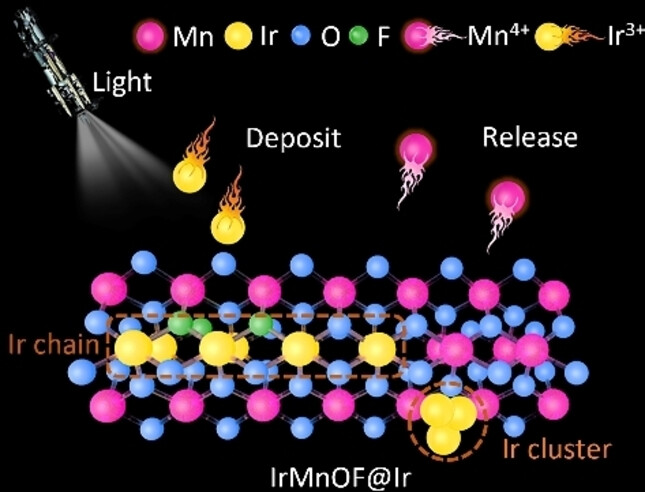
Herein, we propose an intriguing light-driven orderly assembly strategy for implanting Ir-chains and clusters onto catalyst surfaces with different order degrees. Interestingly, the dynamic orbital interaction between orderly Ir-atomic chains and clusters can be regulated by balancing the dissolution and redisposition rate. As a result, the activation energy in acidic OER can be effectively reduced by integrating a dynamic reaction pathway.
DNA Nanotechnology | Hot Paper
Precise Epitope Organization with Self-adjuvant Framework Nucleic Acid for Efficient COVID-19 Peptide Vaccine Construction
- First Published: 24 March 2023
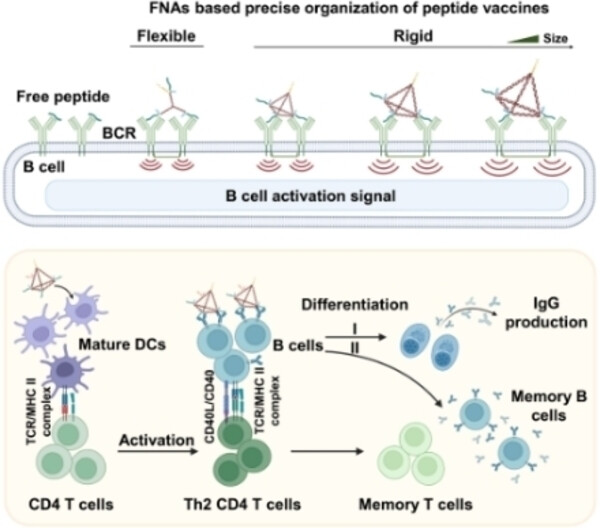
Framework nucleic acids (FNAs)-based peptide vaccines with different structures and sizes were constructed to understand the effect of peptide spacing and carrier rigidity on B cell activation, and reveal the significance of precise peptide organization. Epitopes from SARS-CoV-2 were assembled on the preferred FNA to construct a COVID-19 peptide vaccine prototype which effectively triggered humoral immune responses in mice.
Amination Reactions
Practical Access to meta-Substituted Anilines by Amination of Quinone Imine Ketals Derived from Anisidines: Efficient Synthesis of Anti-Psychotic Drugs
- First Published: 20 March 2023
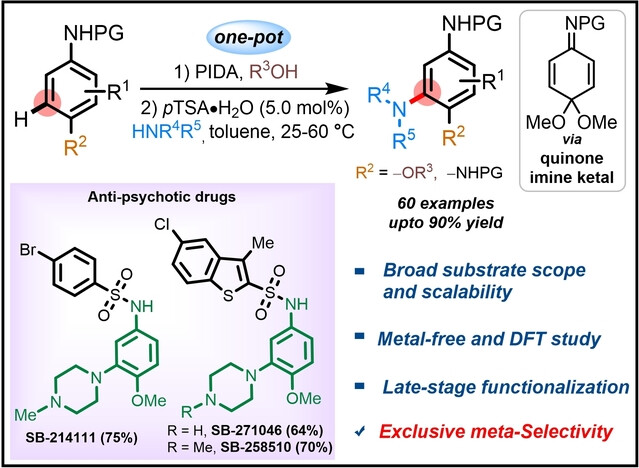
The Brønsted acid-catalyzed meta-amination of arylamines with aliphatic, heterocyclic and aromatic amines is reported based on a one-pot procedure. The strategy is based on direct C−N bond formation for the practical synthesis of meta-substituted anilines, thus reversing the conventional site-selectivity. A concise and efficient synthesis of anti-psychotics and in particular of anti-schizophrenic drugs is shown.
Inhibitors
Vinyl Halide-Modified Unsaturated Cyclitols are Mechanism-Based Glycosidase Inhibitors
- First Published: 20 March 2023
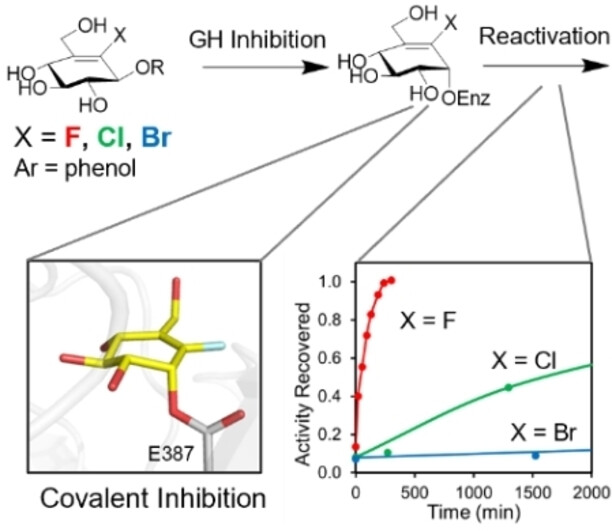
Cyclohexene-based carbohydrate mimics have been shown to react with glycoside hydrolases via positively charged, allylic cation-like transition states. By incorporating electron-withdrawing halogens at the vinyl position of the allyl ethers of these sugar mimics, potent inhibitors of β-glycosidases were prepared. This approach is orthogonal to existing strategies and offers a new tool to probe glycosidase active sites.
Homogeneous Catalysis
An Electron-Deficient CpE Iridium(III) Catalyst: Synthesis, Characterization, and Application to Ether-Directed C−H Amidation
- First Published: 14 March 2023

A highly electron-deficient cyclopentadienyl iridium(III) complex was developed ([CpEIrI2]2). This complex effectively catalyzed weakly coordinating ether-directed C−H amidation reactions under mild reaction conditions. Mechanistic experiments and DFT calculations indicated that the high catalytic activity of the [CpEIrI2]2 complex is attributed to its highly electron-deficient nature.
Fluorine Chemistry
Interaction between Divalent Copper Fluoride and Carboxamide Group Enabling Stereoretentive Fluorination of Tertiary Alkyl Halides
- First Published: 20 March 2023

A copper-catalyzed stereospecific fluorination reaction allowed to achieve the synthesis of molecules bearing F-containing tertiary carbon stereogenic center that are otherwise difficult to synthesize. Based on the use of enantio-enriched α-halocarboxamides and inexpensive CsF, the reaction could be controlled by efficient divalent-Cu/carboxamide interactions. This new methodology enables to generate the tert-alkyl fluorides in a stereoretentive manner.
Nanographenes
Heptagon-Containing Nanographene Embedded into [10]Cycloparaphenylene
- First Published: 21 March 2023
Oxygen Reduction | Hot Paper
Approaching Theoretical Performances of Electrocatalytic Hydrogen Peroxide Generation by Cobalt-Nitrogen Moieties
- First Published: 22 March 2023
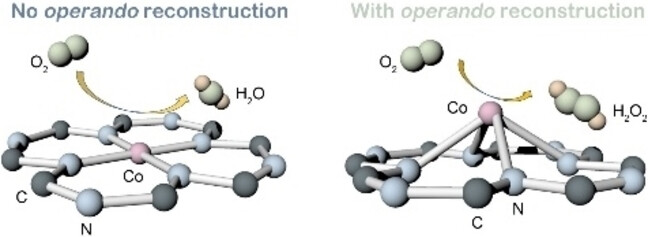
A series of CoNx/carbon nanotube hybrids as oxygen reduction electrocatalysts were studied through electrochemical and operando spectroscopic methods. When cathodically biased, a reconstruction in the symmetry of Co−Nx active sites is discovered, which leads to a shift in the electrocatalytic oxygen reduction reaction selectivity from producing water to hydrogen peroxide.
Surface Chemistry
Alcohol-Induced Strong Metal-Support Interactions in a Supported Copper/ZnO Catalyst
- First Published: 15 March 2023
Synthetic Methods
Dearomatization-Rearomatization Reaction of Metal-Polarized Aza-ortho-Quinone Methides
- First Published: 17 March 2023

Three sequential dearomatization-rearomatization reactions of benzoxazinones with aza-sulfur ylides were developed under transition metal catalysis. Pharmaceutically significant bis-nitrogen heterocycles, benzimidazolines and dibenzodiazepines, were produced with high efficiency and selectivity. Furthermore, detailed mechanism studies were carried out to explain the proposed mechanism and reaction selectivity.
Fluorescent Probes
Hemin as a General Static Dark Quencher for Constructing Heme Oxygenase-1 Fluorescent Probes
- First Published: 20 March 2023

Hemin was identified as a broad-spectrum (400–700 nm) and highly efficient (quenching efficiency >97 %) dark quencher for designing “turn-on” fluorescent probes. Based on this initial discovery, the first live cell-applicable fluorescent probe of heme oxygenase-1 (HO-1) was disclosed and a convenient fluoroassay was developed for determining HO-1 activity in biological samples.
Biosensors
A Hydrogel Microneedle Assay Combined with Nucleic Acid Probes for On-Site Detection of Small Molecules and Proteins
- First Published: 22 March 2023
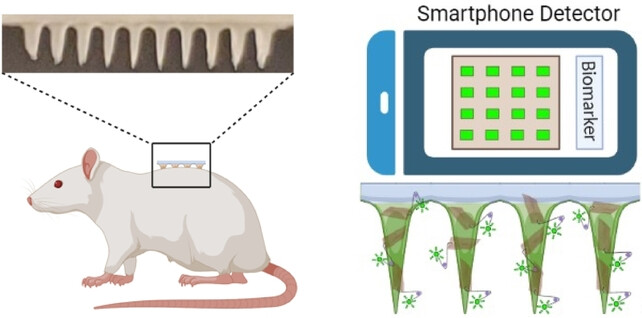
Here, we have developed a versatile microneedle (MN) biosensor applicable for detecting various clinical biomarkers, present in interstitial fluid, on-site and near a patient's point of care. Our MN-based biosensor has displayed accurate and reliable results at in vitro, ex vivo, and in vivo settings when compared to benchmark assays. The developed MN paves the way for better health management and timely treatment.
Microporous Materials | Hot Paper
Detachable Porous Organic Polymers Responsive to Light and Heat
- First Published: 17 March 2023
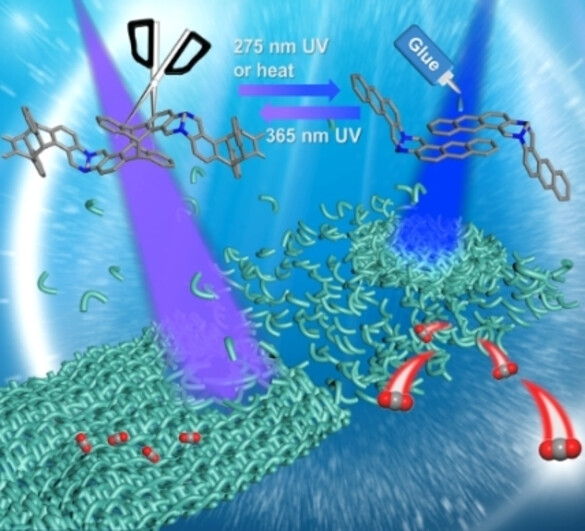
A new type of stimuli-responsive porous material was prepared based on the detachment mechanism. The detachable porous polymer, namely DT-POP-1, was fabricated by the polymerization of anthracene-containing monomer with 365 nm UV light and it can detach into the monomer upon irradiation with 275 nm UV light or heat. The detachment results in a large difference in porosity and adsorption capacity.
Mg Metal Batteries
Revealing the Interfacial Chemistry of Fluoride Alkyl Magnesium Salts in Magnesium Metal Batteries
- First Published: 22 March 2023
Solar Cells | Very Important Paper
Nickel(II) Nitrate Hole-Transporting Layers for Single-Junction Bulk Heterojunction Organic Solar Cells with a Record 19.02 % Efficiency
- First Published: 17 March 2023
NMR Spectroscopy
Circularly Polarized Luminescence | Hot Paper
Metal-Induced Planar Chirality of Soft-Bridged Binuclear Platinum(II) Complexes: 100 % Phosphorescence Quantum Yields, Chiral Self-Sorting, and Circularly Polarized Luminescence
- First Published: 20 March 2023
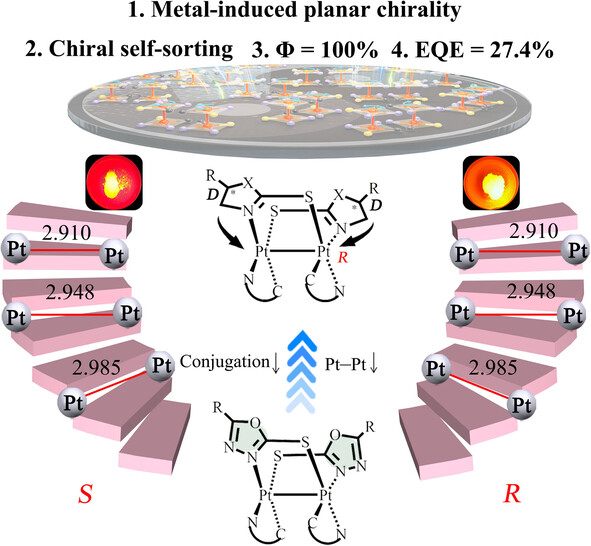
Racemic (R)/(S) and enantiopure (D,R,D)/(L,S,L) binuclear PtII complexes with metal-induced planar chirality were designed and prepared by using soft-bridged achiral and chiral ligands, respectively. Their phosphorescence quantum yields up to 100 % can be achieved by shortening intramolecular Pt−Pt distance for highly efficient solution-processed circularly polarized OLEDs.
Perovskite LEDs
Manipulating Local Lattice Distortion for Spectrally Stable and Efficient Mixed-halide Blue Perovskite LEDs
- First Published: 03 March 2023

A new local lattice distortion (LLD) manipulation strategy was demonstrated to suppress the halide migration in mixed-halide perovskite. DFT simulation and experimental data confirm that the LLD manipulation effectively suppresses the halide migration in perovskites. Mixed-halide blue PeLED with champion EQE of 14.2 % at 475 nm and impressive T50 of 72 min has been achieved, representing the state-of-the-art pure-blue PeLEDs.
Supramolecular Photocatalysts
Two-dimensional Supramolecular Polymers Based on Selectively Recognized Aromatic Cation-π and Donor-Acceptor Motifs for Photocatalytic Hydrogen Evolution
- First Published: 21 March 2023

This is the first demonstration of an aromatics-selective recognition strategy for cation-π and donor-acceptor motifs that avoid their mutual interference, thus enabling the construction of two-dimensional supramolecular polymers (2DSPs), which exhibit boosted photocatalytic hydrogen evolution activity.
Aqueous Zn Batteries | Very Important Paper
Regulating the Inner Helmholtz Plane with a High Donor Additive for Efficient Anode Reversibility in Aqueous Zn-Ion Batteries
- First Published: 23 March 2023
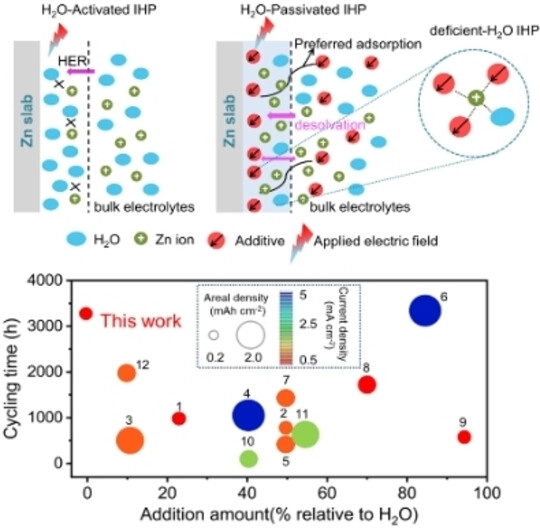
The performance of aqueous Zn-ion batteries is improved by regulating the inner Helmholtz plane (IHP) chemistry. Pyridine (Py) as high donor number organic electrolyte additive (only 1 vol. % addition) is used to efficiently regulate the solvation sheath structure, which results in depressed H2O activity at the IHP interface. The thus-formed IHP interface enables a superior stable Zn anode with high reversibility and utilization rate.
Indole Alkaloids
Collective Total Synthesis of Mavacuran Alkaloids through Intermolecular 1,4-Addition of an Organolithium Reagent
- First Published: 16 March 2023

Intermolecular 1,4-addition of a functionalized vinyl lithium reagent to a readily accessible Michael acceptor enabled the synthesis of six mavacuran alkaloids with a highly strained pentacyclic cagelike framework. The chemo- and diastereoselectivity of the reaction was rationalized by DFT calculations. Dihydroxylation and pinacol rearrangement of the indole nucleus completed the first total syntheses of C-profluorocurine and C-fluorocurine.
Gas Separation
A Microporous Metal-Organic Framework with Unique Aromatic Pore Surfaces for High Performance C2H6/C2H4 Separation
- First Published: 20 March 2023
Photocatalytic Materials
Graphene Mediates Charge Transfer between Lead Chromate and a Cobalt Cubane Cocatalyst for Photocatalytic Water Oxidation
- First Published: 23 March 2023
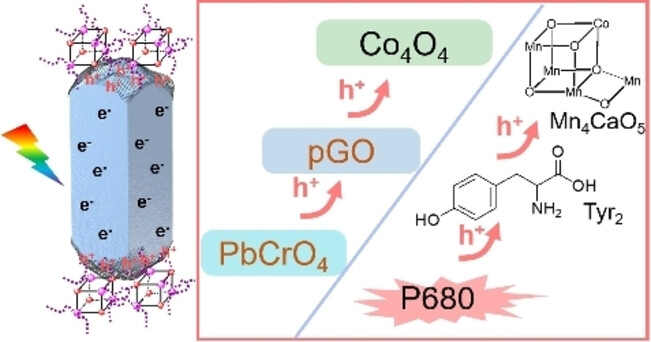
Partially oxidized graphene (pGO) operates as a charge-transfer mediator between the water oxidation cocatalyst (Co4O4) and the hole-accumulating {−101} facets of PbCrO4. Unimpeded transfer of photogenerated holes from PbCrO4 to Co4O4 via the pGO mediator is demonstrated. The resulting Co4O4/pGO/PbCrO4 photocatalyst oxidizes water with an apparent quantum efficiency exceeding 10 % at 500 nm.
Small Ring Systems | Hot Paper
Facile Access to Cyclopropylboronates via Stereospecific Deborylative Cyclization: A Leaving Group-Assisted Activation of Geminal Diborons
- First Published: 24 March 2023

A transition metal-free deborylative cyclization strategy led to the efficient synthesis of racemic and enantioenriched cyclopropylboronates. The cyclization of geminal-bis(boronates) bearing a leaving group was highly diastereoselective and stereospecific, tolerating various functional groups and heterocycles. Mechanistic studies indicated that the leaving group at the γ-position significantly promoted the activation of the gem-diboron moiety.
Atropisomers | Hot Paper
Atroposelective Three-Component Coupling of Cyclic Diaryliodoniums and Sodium Cyanate Enabled by the Dual-Role of Phenol
- First Published: 22 March 2023

An atroposelective copper-catalyzed three-component coupling of cyclic diaryliodonium, cyanate and phenols is used to synthesize axially chiral carbamates. The success of this coupling is attributed to the key dual role of phenols, which are capable of activating the copper catalyst and trapping the isocyanate intermediate.
Polycyclic Hydrocarbons
Facile Synthesis of Nitrogen-Doped Nanographenes with Joined Nonhexagons via a Ring Expansion Strategy
- First Published: 21 March 2023
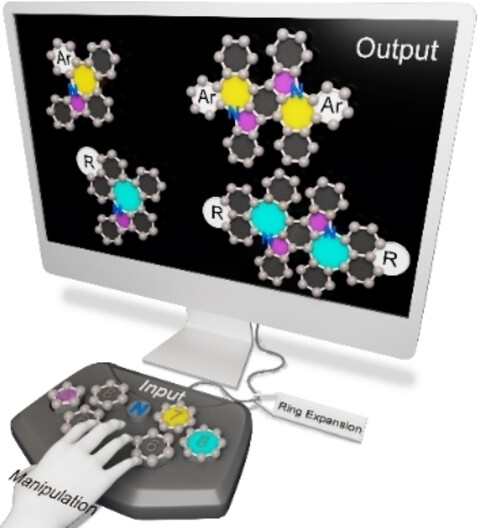
In this study, novel nanographenes bearing N-doped pentagon-heptagon pairs were synthesized through a facile ring expansion strategy. Modifications of heptagon spacers have endowed N-doped nanographenes with tunable physicochemical properties. This ring expansion method was further explored to synthesize diverse N-doped nanographenes containing pentagon-octagon pairs, demonstrating the high efficiency of the proposed method.
Flow Chemistry
Fast Isomerization Before Isomerization-Hydroformylation: Probing the Neglected Period with A Novel Microfluidic Device
- First Published: 20 March 2023
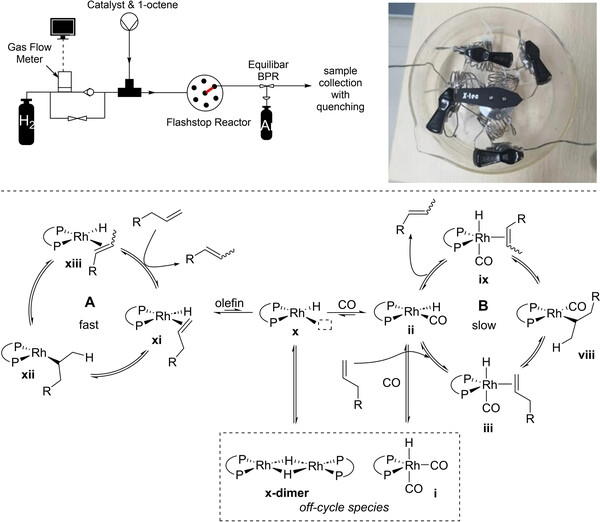
Due to limits in heat and mass transfer, the acquisition of kinetic data of fast reactions has been historically challenging, especially for multiphasic reactions. Inspired by the concept of flash chemistry and radial synthesis, a novel microreactor was designed to study the initial fast isomerization process (within the first minute) in rhodium-catalyzed hydroformylation. A new type of isomerization pathway without the coordination of CO to rhodium center was found, which is dramatically faster than the known one.
Fuel Cell
A Direct Formaldehyde Fuel Cell for CO2-Emission Free Co-generation of Electrical Energy and Valuable Chemical/Hydrogen
- First Published: 22 March 2023
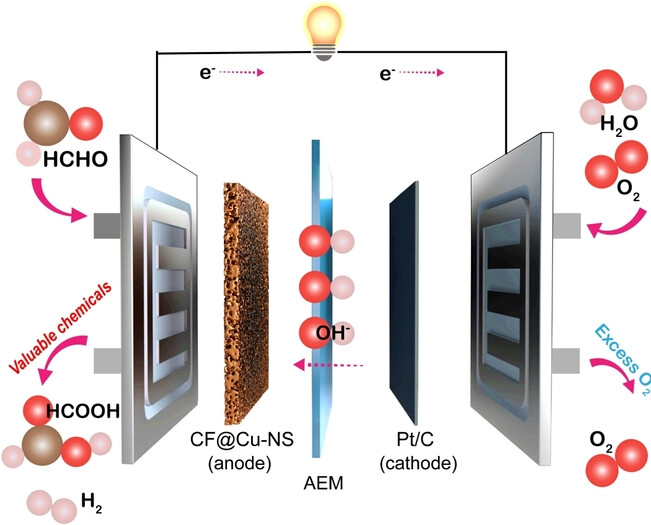
Highly selective 1-electron oxidation of formaldehyde enables co-generation of electricity and H2 with valuable formate in a direct formaldehyde fuel cell without CO2 pathway. This approach not only avoids greenhouse gas emissions but also eliminates negative effects of CO poisoning and carbonate generation.
MOF Membranes | Hot Paper
Highly-Efficient Ion Gating through Self-Assembled Two-Dimensional Photothermal Metal-Organic Framework Membrane
- First Published: 21 March 2023
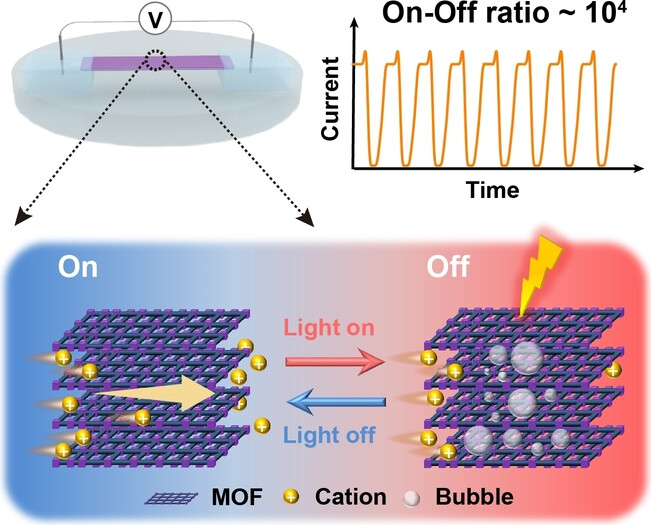
A self-assembled 2D metal-organic framework (MOF) membrane is shown to be an excellent nanofluidic platform for the smart regulation of transverse ion transport. It exhibits extremely high ion gating ratios (up to 104) due to its good photothermal performance. This approach may lead to applications of MOF membranes which have a variety of stimuli responsive properties in ion sieving, biosensing, and energy conversion.
Zn-I2 Batteries | Very Important Paper
Organic pH Buffer for Dendrite-Free and Shuttle-Free Zn-I2 Batteries
- First Published: 22 March 2023
Uranium Complexes | Hot Paper
Complexes Featuring a cis-[M U
U M] Core (M=Rh, Ir): A New Route to Uranium-Metal Multiple Bonds
M] Core (M=Rh, Ir): A New Route to Uranium-Metal Multiple Bonds
- First Published: 23 March 2023
![Complexes Featuring a cis-[M
U
M] Core (M=Rh, Ir): A New Route to Uranium-Metal Multiple Bonds](/cms/asset/73e06060-bb12-4773-a63d-644853f1c382/ange202303379-toc-0001-m.jpg)
Complexes featuring two U M double dative bonds are prepared from the reaction of heterometallic chlorine-bridged precursors with MeMgBr or MeLi. This study shows a novel synthetic method for complexes with U−M multiple bonds, and also provides new examples with which to investigate the bonding of 5 f-block actinide elements.
M double dative bonds are prepared from the reaction of heterometallic chlorine-bridged precursors with MeMgBr or MeLi. This study shows a novel synthetic method for complexes with U−M multiple bonds, and also provides new examples with which to investigate the bonding of 5 f-block actinide elements.
Organocatalysis
Bifunctional Iminophosphorane-Catalyzed Enantioselective Nitroalkane Addition to Unactivated α,β-Unsaturated Esters
- First Published: 16 March 2023

The first intermolecular enantioselective addition of nitroalkanes to unactivated α,β-unsaturated esters is described, catalyzed by a bifunctional iminophosphorane (BIMP) superbase. This fundamental synthetically relevant transformation proceeds with high enantiomeric excesses and yields over a wide range of feedstock substrates, providing pharmaceutically relevant building blocks in a single step.
Oxygen Reduction Reaction | Hot Paper
Singlet Oxygen Induced Site-Specific Etching Boosts Nitrogen-Carbon Sites for High-Efficiency Oxygen Reduction
- First Published: 21 March 2023
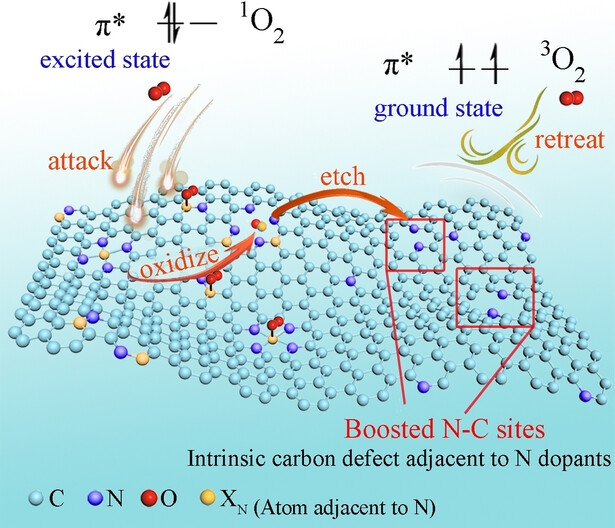
Singlet oxygen (1O2) specifically targets the N-adjacent atoms and acts as an etchant to realize site-specific etching of topological carbon defects neighboring the N-dopants, leading to a boosted intrinsic catalytic activity of the N−C sites in the resultant N-doped carbon (1O2−N/C). The 1O2−N/C exhibits the highest half-wave potential of 0.915 VRHE toward oxygen reduction reaction among all the metal-free carbon catalysts reported to date.
Electrocatalysis
Spectroscopic Identification of Active Sites of Oxygen-Doped Carbon for Selective Oxygen Reduction to Hydrogen Peroxide
- First Published: 16 March 2023
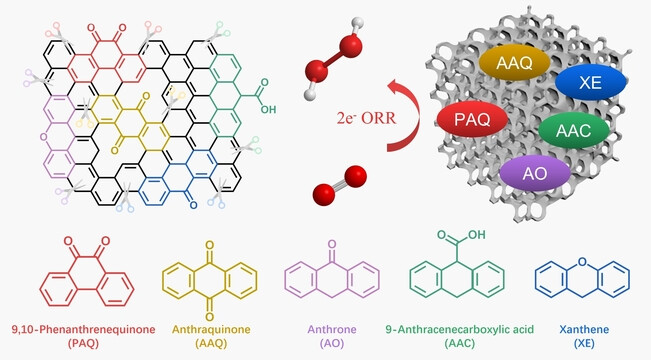
The quinone-doped carbon electrocatalyst exhibits a remarkable onset potential of 0.83 eV vs. RHE in 0.1 M KOH and over 95 % H2O2 selectivity in both alkaline and neutral electrolytes. The effectiveness of chair-form quinone groups as the most efficient active sites is highlighted by the reverse verification method, compared with other oxygen functional groups.
Analytical Methods | Very Important Paper
A Fluid Multivalent Magnetic Interface for High-Performance Isolation and Proteomic Profiling of Tumor-Derived Extracellular Vesicles
- First Published: 23 March 2023
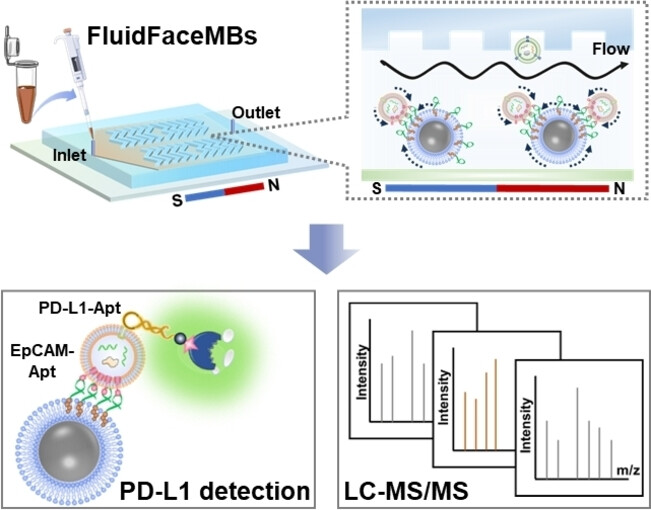
A fluid multivalent magnetic interface was engineered in a microfluidic chip to improve the kinetics and thermodynamics of biomolecular recognition for efficient isolation of tumor-derived extracellular vesicles (T-EVs). With the assistance of magnetic and flow fields, this interface balanced affinity, selectivity, reversibility, and extendibility, enabling high-throughput recovery of T-EVs for protein profiling.
Polyzyklische Verbindungen
Modulare Synthese von strukturell diversen polyzyklischen aromatischen Kohlenwasserstoffen mit eingebetteten Azulenen durch Knoevenagelartige Kondensation
- First Published: 06 March 2023

Eine effiziente und modulare Synthesestrategie für die Konstruktion von neuen azuleneingebetteten PAKs mit guter struktureller Diversität wurde entwickelt. Die Beziehungen zwischen chemischer Struktur, Aromatizität und photophysischen Eigenschaften der dargestellten nicht-alternierenden PAKs wurden vollständig untersucht. Diese Strategie bietet einen unkomplizierten Ansatz für die zügige Konstruktion noch unerforschter nicht-alternierender PAKs oder sogar Graphennanostreifen mit mehreren Azuleneinheiten.
MOF-Nanohybride | Hot Paper
Eine universelle Synthesestrategie für anpassbare metallorganische Gerüst-Nanohybride
- First Published: 06 March 2023
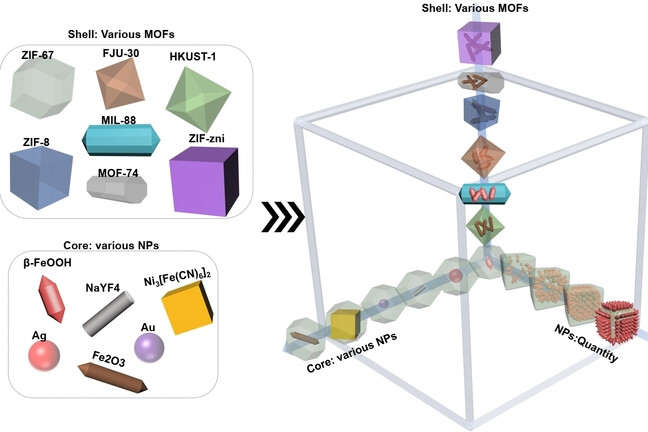
Hier zeigen wir eine vielseitige, allgemeine Synthesestrategie unter Verwendung einer repräsentativen Auswahl von sieben MOF-Hüllen (ZIF-zni, ZIF-8, ZIF-67, FJU-30, MIL-88(Fe), HKUST-1 und MOF-74(Co)) und sechs Kernen (Ag, Au, NaYF4, β-FeOOH, Fe2O3 und Ni3[Fe(CN)6]2), die so aufeinander abgestimmt sind, dass sie von einem bis zu Hunderten von Kernen in mono-, bi-, tri- und quaternären Verbundwerkstoffen eingesetzt werden können.
Präbiotische Chemie | Hot Paper
Beladung von RNA mit Aminosäuren in einer putativen RNA-Peptid-Welt
- First Published: 07 March 2023
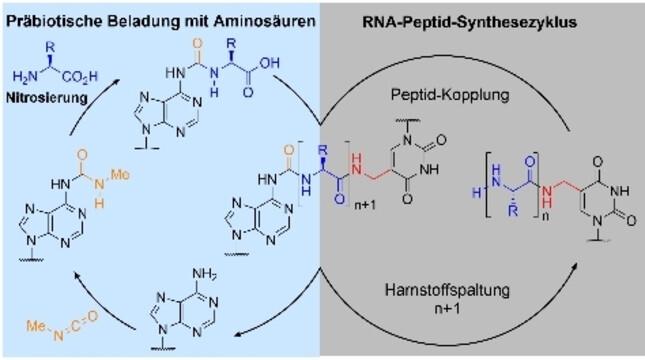
Die Beladung der RNA mit Aminosäuren ist der erste Schritt zur RNA-basierten Peptidsynthese in einer putativen präbiotischen RNA-Peptid-Welt. Es wird über die effiziente Beladung von RNA-Strängen, die N-Methylcarbamoyl-Nukleotide enthalten, mit einer Reihe von Aminosäuren berichtet. Mit den beladenen RNA-Stränge konnten auch RNA-basierten Aminosäure-Transferreaktionen durchgeführt werden.
Zuschriften
Cellular Nanodiscs | Hot Paper
Synthesis of Erythrocyte Nanodiscs for Bacterial Toxin Neutralization
- First Published: 28 February 2023
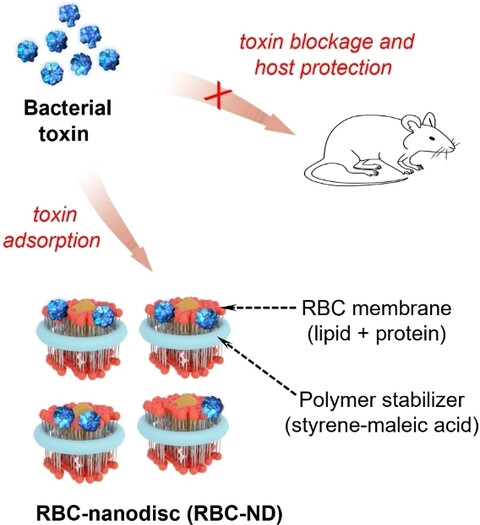
Nanodiscs are small discoidal lipid bilayer assemblies and represent an attractive nanomedicine platform. While most nanodiscs are made with synthetic lipid bilayers, this work reports on a nanodisc formulation made with natural human red blood cell membrane and demonstrates its robust application for bacterial toxin neutralization.
Membranes | Hot Paper
Lipophilicity Modulations by Fluorination Correlate with Membrane Partitioning
- First Published: 18 March 2023

A novel solid-state 19F MAS NMR method was developed to accurately and easily measure water-membrane partitioning values (Kp). Given the very different octanol and membrane environments, a remarkable correlation between logKp and logP was found, but only for a given compound series. This work indicates that even minor lipophilicity modulations by aliphatic fluorination can have true relevance for the drug discovery optimization process.
Organocatalysis
Bifunctional NHC-Catalyzed Remote Enantioselective Mannich-type Reaction of 5-(Chloromethyl)furfural via Trienolate Intermediates
- First Published: 24 March 2023

NHC-catalyzed enantioselective Mannich-type reactions of 5-(chloromethyl)furfural (CMF), an important biomass-derived platform chemical, with aldimines afford chiral amines in good yields with excellent regio- and enantioselectivities. The use of a bifunctional NHC bearing a free hydroxy group enabled the remote addition of the trienolate intermediate to the imine to occur in a highly stereocontrolled manner.
Supramolecular Chemistry | Very Important Paper
Synthesis of Cationic Biphen[4, 5]arenes as Biofilm Disruptors
- First Published: 16 March 2023
![Synthesis of Cationic Biphen[4, 5]arenes as Biofilm Disruptors](/cms/asset/09fea856-714a-4311-b2dd-2793101ad616/ange202301857-toc-0001-m.jpg)
Cationic biphen[n]arenes were designed and synthesized, which could inhibit biofilm formation and eradicate stubborn mature biofilms. Moreover, their effective complexation with the conventional antibiotic cefazolin sodium could further enhance the biofilm disruption efficacy in vitro and synergistically improve the healing effect in E. coli-infected mice.
Bioactive Compounds
Morphological Profiling Identifies the Motor Protein Eg5 as Cellular Target of Spirooxindoles
- First Published: 16 March 2023
Oxygen Electrocatalysis
A Bifunctional Electrocatalyst for OER and ORR based on a Cobalt(II) Triazole Pyridine Bis-[Cobalt(III) Corrole] Complex
- First Published: 23 February 2023
![A Bifunctional Electrocatalyst for OER and ORR based on a Cobalt(II) Triazole Pyridine Bis-[Cobalt(III) Corrole] Complex](/cms/asset/247b49ac-2634-484a-bf9a-c99b40618dee/ange202302208-toc-0001-m.jpg)
By designing the structure of the catalyst, possessing CoII and CoIII reaction centers, we achieve nearly 100 % selective activity during ORR to H2O2. Similarly, promising results are obtained when applied in OER catalysis. A relatively low overpotential at 10 mA cm−2 of 412 mV, a Faraday efficiency of 98 % for oxygen evolution, and an outstanding Tafel slope of 64 mV dec−1 are combined with a superior stability.
Rotaxanes
Reactivity of Glutaconamides Within [2]Rotaxanes: Mechanical Bond Controlled Chemoselective Synthesis of Highly Reactive α-Ketoamides and their Light-Triggered Cyclization
- First Published: 23 March 2023
![Reactivity of Glutaconamides Within [2]Rotaxanes: Mechanical Bond Controlled Chemoselective Synthesis of Highly Reactive α-Ketoamides and their Light-Triggered Cyclization](/cms/asset/73c4e546-d6c5-4987-9f27-cf9ef4b6bd34/ange202302681-toc-0001-m.jpg)
The mechanical interlocking of glutaconamides is crucial for their chemoselective oxidation to β,γ-unsaturated α-ketoamides. These unprecedented species were satisfactorily employed in blue-light-driven cyclizations to divergently provide hydroxy-2-azetidinones or oxazolidinones through two modes of the Norrish/Yang type-II reaction. This behavior starkly differs from that of the non-interlocked substrates under the same reaction conditions.
Electrosynthesis | Very Important Paper
Base-Promoted Electrochemical CoII-catalyzed Enantioselective C−H Oxygenation
- First Published: 20 March 2023
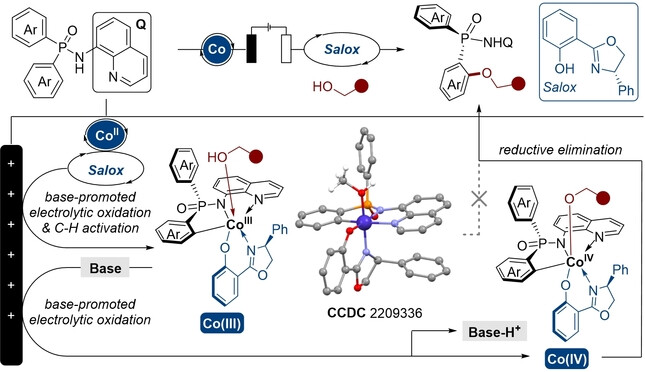
The first electrochemical CoII-catalyzed enantioselective C−H alkoxylation is reported. A broad range of alkoxylated phosphinamides were obtained in good yields with excellent enantioselectivities (up to 98 % yield and >99 % ee). A cobalt(III) alcohol complex was prepared and characterized, and was found to be a key intermediate in this reaction. Mechanistic studies revealed that the oxidation of CoIII to CoIV was facilitated by a base.
Synthetic Methods | Hot Paper
Diastereoselective Synthesis of Cyclopropanes from Carbon Pronucleophiles and Alkenes
- First Published: 16 March 2023
Solar Cells | Very Important Paper
Dimer Acceptor Adopting a Flexible Linker for Efficient and Durable Organic Solar Cells
- First Published: 22 March 2023
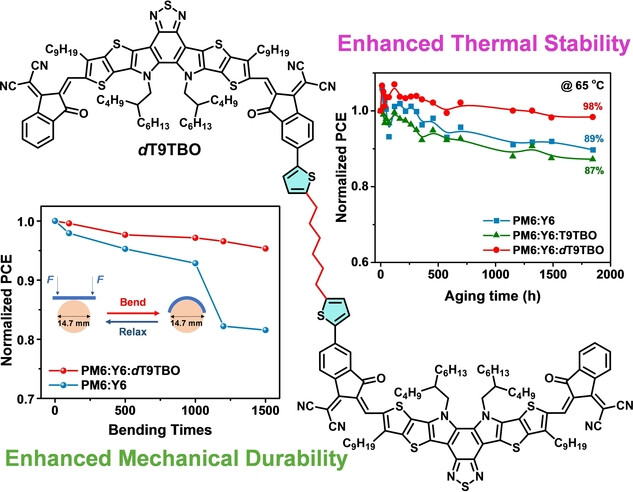
A dimer acceptor with flexible linker was designed and synthesized, which not only acts as the third component to enhance the intermolecular packing, but also stabilize the morphology by suppressing the molecular diffusion. As a result, the PM6 : Y6 : dT9TBO based organic solar cells exhibited a high power conversion efficiency of 18.41 % with excellent thermal/photo stability and mechanical performance.
Organic Synthesis
Hydrogen-Atom-Transfer-Initiated Radical/Polar Crossover Annulation Cascade for Expedient Access to Complex Tetralins
- First Published: 23 March 2023

A radical/polar crossover manifold permits annulations between allylarenes and Giese-type accepters, providing a route to functionalized tetralins. The reaction conditions are mild and therefore exhibit significant functional group tolerance. The annulation products are formally cycloadducts of styrenes and electron-deficient alkenes, and they can be used to form a variety of strained ring products.
Sandwichkomplexe | Hot Paper
Lineares und gewickeltes Cp*2Si: Reversibler Phasendurchgang eines Schlüsselmoleküls
- First Published: 03 March 2023
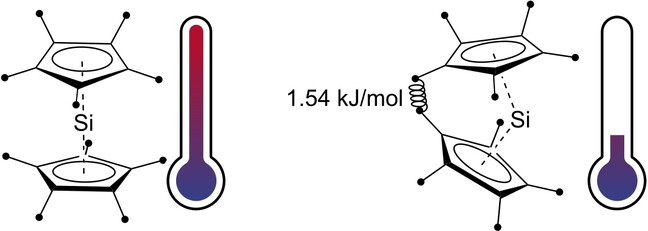
Das metallorganische Schlüsselmolekül Cp*2Si(II) war immer der Sonderling unter den schweren Homologen. Im festen Zustand gibt es kontraintuitiv ein lineares Molekül neben zwei gewinkelten Molekülen. Während letzteres stabiler ist, wurde das lineare Konformer hauptsächlich auf unpräzise Packungseffekte zurückgeführt. Jetzt ist klar, dass die Linearität der Entropie in der Raumtemperaturphase zuzuschreiben ist, während die Winkelung auf die Dispersion der Ringe in der 80 K-Phase zurückzuführen ist.
Atropisomere | Hot Paper
Katalysatorkontrolle über dreifache Stereogenität: Selektive Synthese atropisomerer Sulfone mit stereogenen C−S-Achsen
- First Published: 14 March 2023
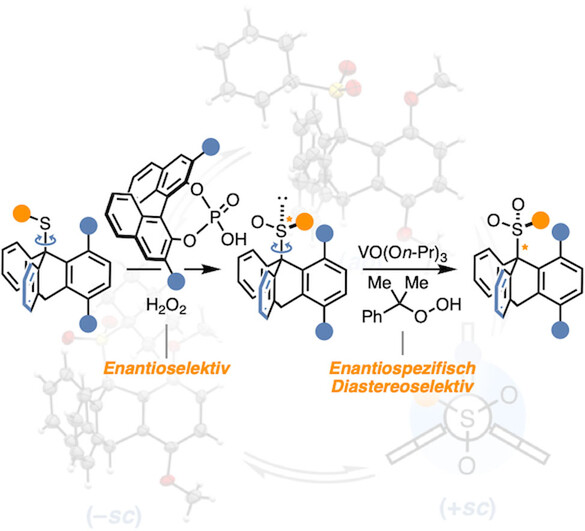
Die Möglichkeit, dreifach stereogene C−S-Atropisomere katalytisch anzusteuern, wird beschrieben. Eine katalytische Oxidationssequenz verläuft ausgehend von Triptycylthioethern über Sulfoxide zu Sulfonen mit einer stereogenen C(sp3)−S-Achse mit einem hohen Maß an Enantio- und Diastereokontrolle, wobei Stereodivergenz zu jedem der drei Atropisomere möglich war.




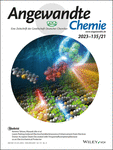



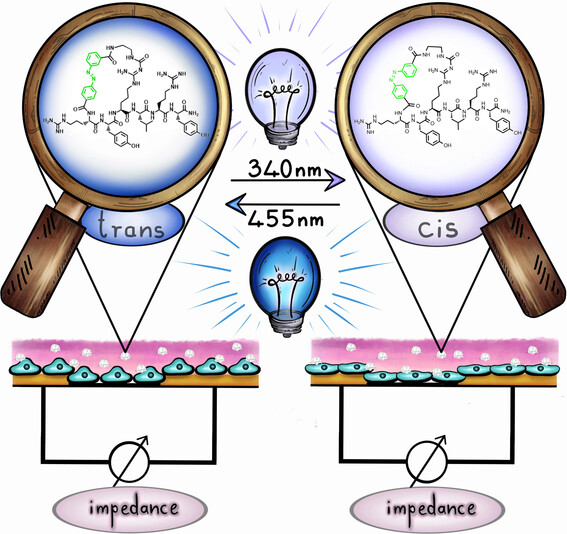


![Heptagon-Containing Nanographene Embedded into [10]Cycloparaphenylene](/cms/asset/cf4a5061-524b-4f0c-88b7-9b06963120e6/ange202301356-toc-0001-m.jpg)
